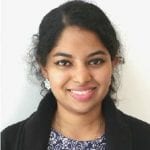When I was little, I would pick out my favourite bedtime story to read every night, tucking the book under one arm and dragging my dad or my mum’s hand with my other arm to the reading corner. At first, I always wanted to read only English books. I don’t remember why – Maybe I thought the books were better? Or maybe I was more confident reading in English? But my mum started to get worried that I was not enjoying my Tamil language as much. My mum is a Tamil teacher, so to ensure that I would enjoy reading in Tamil just as much as I did for English, she would compile newspaper clippings, buy storybooks, bring us to movies and stick up reading charts. This all helped to make sure my growing process in reading was balanced between my languages.
By making reading fun, my parents helped me to practice my language skills. Even now I enjoy reading in all my languages!
What is the most fun thing you do in each of your languages?

Eshwaaree is a Research Assistant in the BLIP Lab, working on the Singapore Talk-a-thon as part of the Language-Mixes Project
***
Today, for the International Day of Multilingualism we’ll be sharing lots of stories about multilingualism in Singapore – what it’s like to grow up in such a multilingual place, how different people feel about their different languages, and some of the core research questions we are working on as a team.








